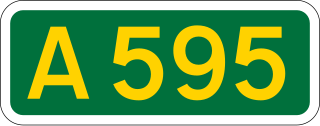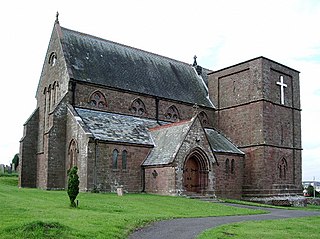
The A595 is a primary route in Cumbria, in Northern England that starts in Carlisle, passes through Whitehaven and goes close to Workington, Cockermouth and Wigton. It passes Sellafield and Ravenglass before ending at the Dalton-in-Furness by-pass, in southern Cumbria, where it joins the A590 trunk road. The road is mostly single carriageway, apart from in central Carlisle, where it passes the castle as a busy dual carriageway road named Castle Way, and prior to that as Bridge Street and Church Street, where it passes close to the McVitie's or Carr's biscuit factory. The Lillyhall bypass is also dual carriageway.

Seascale is a railway station on the Cumbrian Coast Line, which runs between Carlisle and Barrow-in-Furness. The station, situated 33+1⁄4 miles (54 km) north-west of Barrow-in-Furness, serves the village of Seascale in Cumbria. It is owned by Network Rail and managed by Northern Trains.

St Bees is a coastal village, civil parish and electoral ward in the Copeland district of Cumbria, England, on the Irish Sea.

Foxfield is a railway station on the Cumbrian Coast Line, which runs between Carlisle and Barrow-in-Furness. The station, situated 11+1⁄2 miles (19 km) north of Barrow-in-Furness, serves the villages of Broughton-in-Furness and Foxfield in Cumbria. It is owned by Network Rail and managed by Northern Trains.

Sellafield is a railway station on the Cumbrian Coast Line, which runs between Carlisle and Barrow-in-Furness. The station, situated 35 miles (56 km) north-west of Barrow-in-Furness, serves Sellafield in Cumbria. It is owned by Network Rail and managed by Northern Trains.

Egremont is a market town, civil parish and two electoral wards in Cumbria, England, and historically part of Cumberland. It is situated just outside the Lake District National Park, five miles south of Whitehaven and on the River Ehen.

Gosforth is a village, civil parish and electoral ward in the Lake District, in the Borough of Copeland in Cumbria, England. Historically in Cumberland, it is situated on the A595 road between Whitehaven and Barrow-in-Furness. It had a population of 1,230 at the 2001 Census. At the 2011 census Gosforth was grouped with Ponsonby and Wasdale giving a total population of 1,396.

The village of Silecroft in Cumbria, England, is in the parish of Whicham. It is situated between the towns of Millom and Bootle, and also neighbours the towns/villages of Haverigg, Kirksanton and Whitbeck.

Beckermet is a village and civil parish in Cumbria, England, between Egremont and Seascale. The parish had a population of 1,619 in the 2011 census.

Braystones is a village in Cumbria, England, historically within Cumberland. It is located on the Irish Sea coast, on edge of the Lake District National Park, around 38.6 miles (62.1 km) north of Barrow-in-Furness, 9.9 miles (15.9 km) south of Whitehaven and 50.8 miles (81.8 km) south west of Carlisle.

Parton is a village and civil parish on the Cumbrian coast, overlooking the Solway Firth, 1¼ miles (2 km) of Whitehaven in England. The parish had a population of 924 in 2001, decreasing to 914 at the 2011 Census. Formerly a port and a mining centre located on the A595 trunk road and the Cumbrian Coast railway line.

Beckermet railway station is a disused rail station located in the village of Beckermet in Cumbria.

Distington is a large village and civil parish in Cumbria, England, 3 miles (4.8 km) south of Workington and 4 miles (6.4 km) north of Whitehaven. Historically a part of Cumberland, the civil parish includes the nearby settlements of Common End, Gilgarran and Pica. The parish had a population of 2,247 in the 2001 census, increasing slightly to 2,256 at the 2011 census.

The Cumbria shootings was a shooting spree which occurred on 2 June 2010 when a lone gunman, taxi driver Derrick Bird, killed twelve people and injured eleven others in Cumbria, England, United Kingdom. Along with the 1987 Hungerford massacre and the 1996 Dunblane school massacre, it is one of the worst criminal acts involving firearms in British history. The shootings ended when Bird killed himself in a wooded area after abandoning his car in the village of Boot.

Holme St Cuthbert is a small village and civil parish in the county of Cumbria, United Kingdom. The village is located approximately 23 miles to the south-west of Carlisle, Cumbria's county town, and was historically in the county of Cumberland.
Egremont railway station was built by the Whitehaven, Cleator and Egremont Railway as the first southern terminus of what would become the Moor Row to Sellafield branch. In 1878 the company was bought out by the LNWR and Furness Railway who operated the line jointly until grouping in 1923.

Whicham is a hamlet and civil parish in Copeland, Cumbria, England. At the 2011 census the parish had a population of 382. The parish includes the villages of Silecroft and Kirksanton and the hamlets of Whicham and Whitbeck. Whicham was recorded in the Domesday Book as Witingham.




















